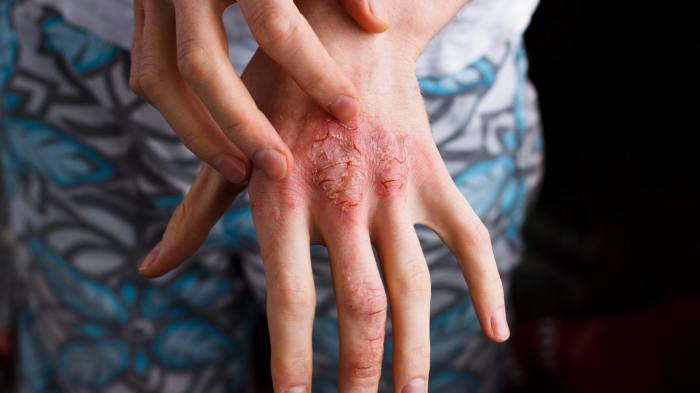Atopic dermatitis vs eczema – are they the same thing? This exploration delves into the similarities and differences between these skin conditions, highlighting their often-overlapping nature. We’ll uncover the historical understanding, examine the underlying causes, and explore the nuances of diagnosis and management. Understanding these distinctions is key to providing the best possible care for those affected.
Atopic dermatitis and eczema often appear similar, making differentiation crucial. This detailed comparison will uncover the subtle but significant distinctions, paving the way for a clearer understanding of these common skin conditions.
Understanding Atopic Dermatitis and Eczema

Atopic dermatitis, often referred to as eczema, is a chronic inflammatory skin condition characterized by dry, itchy, and inflamed skin. These conditions are closely related, with eczema being the broader term encompassing various types of skin inflammation, while atopic dermatitis is a specific subtype often associated with other allergic conditions like asthma and hay fever. Understanding their relationship and historical context helps in effectively managing and treating these common skin issues.The historical understanding of atopic dermatitis and eczema has evolved significantly.
Early descriptions focused on the symptoms, with treatments often relying on soothing topical remedies. Modern research has revealed the complex interplay of genetic, environmental, and immunological factors in the development and progression of these conditions. This deeper understanding allows for more targeted and effective treatment strategies.
While atopic dermatitis and eczema are often used interchangeably, there are subtle differences. Understanding these nuances is key, but sometimes a different health concern like a sinus infection can throw things off. If you’re experiencing sinus pressure, it’s crucial to consult a doctor about the right treatment plan, like antibiotics for sinus infection , as inappropriate treatments can complicate skin conditions like atopic dermatitis.
Ultimately, a proper diagnosis for atopic dermatitis vs. eczema hinges on careful evaluation by a healthcare professional.
Distinguishing Atopic Dermatitis and Eczema
The terms atopic dermatitis and eczema are often used interchangeably, but differentiating them is crucial for accurate diagnosis and treatment. Eczema is a general term for various skin conditions characterized by inflammation, while atopic dermatitis is a specific type of eczema associated with a genetic predisposition to allergies. This predisposition can manifest as other allergic conditions like asthma or hay fever, highlighting the interconnected nature of these diseases.
Common Features of Atopic Dermatitis and Eczema
A comprehensive understanding of these conditions involves recognizing their shared and distinct characteristics. The table below Artikels some common features.
| Symptom Description | Affected Areas | Typical Triggers |
|---|---|---|
| Dry, itchy skin; redness; inflammation; possible weeping or crusting; scaling; skin thickening; and sometimes small bumps or blisters. | Flexural areas (like the inner elbows and knees); face, especially in infants; scalp; hands; and feet. Symptoms can vary depending on the age and individual. | Allergens (dust mites, pollen, pet dander); irritants (soaps, detergents, harsh chemicals); stress; temperature extremes; infections; and certain foods. Exposure to allergens can cause a severe inflammatory response in individuals with a genetic predisposition. |
The symptoms described in the table often vary in intensity and presentation, highlighting the complexity of these conditions. Individual experiences can differ greatly, emphasizing the importance of personalized approaches to diagnosis and management.
Similarities: Atopic Dermatitis Vs Eczema
Atopic dermatitis (AD) and eczema are often used interchangeably, reflecting their significant overlap. While distinct conditions can sometimes exist, the shared characteristics frequently blur the lines between them, making precise diagnosis and management challenging. This section will delve into the similarities between AD and eczema, focusing on their underlying causes, clinical presentations, and risk factors.Underlying causes and mechanisms of AD and eczema share a common thread: a complex interplay of genetic predisposition and environmental factors.
Both conditions involve an aberrant immune response, leading to inflammation and skin barrier dysfunction. Genetic variations predisposing individuals to both AD and eczema often involve genes controlling the skin’s barrier function and the immune system’s response to allergens and irritants. This intricate interplay results in an increased susceptibility to both skin conditions.
Shared Clinical Presentations and Diagnostic Challenges
The clinical presentations of AD and eczema can be remarkably similar, often presenting as itchy, inflamed skin lesions. This similarity frequently poses diagnostic challenges, requiring a thorough assessment by a dermatologist to distinguish between the two. Different patterns of skin involvement, including the distribution of rashes and the presence of other symptoms, can provide clues. A detailed patient history and physical examination are essential for accurate diagnosis.
Overlapping Symptoms and Manifestations
Both atopic dermatitis and eczema often exhibit similar symptoms. Dry, itchy skin is a common feature, often accompanied by redness, scaling, and inflammation. The location of the lesions can vary, though some areas, such as the folds of the elbows and knees, are frequently affected. In children, facial involvement is also common. These overlapping symptoms highlight the difficulty in distinguishing between AD and eczema without a deeper analysis of the individual case.
Shared Risk Factors and Predisposing Genetic Conditions
A shared constellation of risk factors contributes to the development of both AD and eczema. A family history of allergic diseases, such as asthma or hay fever, is a significant risk factor for both conditions. Exposure to environmental allergens, irritants, and infections also plays a critical role in triggering or exacerbating both AD and eczema. Certain genetic predispositions, such as mutations in genes related to the skin barrier, increase the susceptibility to both conditions.
It is important to note that these factors are not mutually exclusive, and their interplay can significantly influence the severity and presentation of both diseases.
Table of Overlapping Diagnostic Criteria and Symptoms
| Characteristic | Atopic Dermatitis | Eczema | Ambiguity |
|---|---|---|---|
| Skin Lesions | Erythematous, itchy, and often excoriated plaques, typically in flexural areas | Variable, including erythema, papules, vesicles, and lichenification, possibly in flexural areas | Both conditions can manifest similarly, making visual differentiation difficult |
| Pruritus (Itching) | Intense, often nocturnal itching | Itching is a prominent feature, though intensity can vary | Severity of itching doesn’t always provide a clear distinction |
| Age of Onset | Often begins in infancy or early childhood | Can manifest at any age, though often diagnosed in infants or children | Age alone is not a definitive diagnostic criterion |
| Family History | Strong association with family history of atopy (allergies, asthma) | Family history of atopy is often a risk factor | Shared genetic predisposition creates overlap |
| Associated Symptoms | Possible associated symptoms include asthma, allergic rhinitis, and food allergies | May show similar associated symptoms | The presence of associated symptoms can aid but not always guarantee distinction |
The table above highlights the overlapping diagnostic criteria and symptoms associated with AD and eczema. Note the areas of ambiguity, emphasizing the need for a comprehensive assessment by a healthcare professional for accurate diagnosis and appropriate management.
Differences

While atopic dermatitis and eczema are closely related, subtle yet significant differences exist. Understanding these distinctions is crucial for accurate diagnosis and effective treatment. These variations impact the severity, chronicity, and response to treatment, as well as the associated health complications.These differences stem from the complex interplay of genetic predisposition, environmental triggers, and immune system responses. While both conditions manifest as skin inflammation, the specific characteristics and underlying mechanisms can vary.
Distinct Features
Atopic dermatitis, a chronic inflammatory skin condition, is characterized by specific features like intense itching, dry skin, and recurring flares. Eczema, a broader term encompassing various skin conditions, may also exhibit these symptoms, but the underlying causes and characteristics can differ. For example, contact dermatitis, a type of eczema, arises from direct skin contact with allergens, while atopic dermatitis has a more complex, multi-factorial origin.
A key difference lies in the presence of a strong familial tendency for atopic dermatitis, often linked to other allergic conditions like asthma and hay fever.
Severity and Chronicity
Atopic dermatitis typically presents with a more severe and chronic course compared to some forms of eczema. The intensity of itching and inflammation can fluctuate, leading to periods of remission and exacerbation. While eczema can be chronic in some cases, it might not always involve the same degree of severity or persistent itchiness. The severity and chronicity of both conditions can vary significantly from person to person, impacting their quality of life.
Treatment Responses
The response to treatment can also differ between atopic dermatitis and various types of eczema. Atopic dermatitis often requires a multifaceted approach, encompassing moisturizers, topical corticosteroids, and potentially immunomodulatory therapies, to manage symptoms effectively. The efficacy of these treatments can vary depending on the individual and the specific type of eczema. Some forms of eczema may respond well to topical treatments like emollients and avoidance of triggers, while others might necessitate more intensive interventions.
Associated Comorbidities
Atopic dermatitis is frequently associated with other allergic conditions, such as asthma and allergic rhinitis. These comorbidities often appear in a pattern, highlighting the interconnectedness of immune responses. While eczema can sometimes be linked to allergies, the specific comorbidities associated with different types of eczema can differ.
Comparison Table
| Feature | Atopic Dermatitis | Eczema (Various Types) |
|---|---|---|
| Severity | Generally more severe, with frequent and intense flares. | Severity varies depending on the specific type of eczema. |
| Duration | Chronic, often persistent, with periods of remission and exacerbation. | Can be chronic or acute, depending on the specific type and trigger. |
| Treatment Approaches | Multifaceted, often involving moisturizers, topical corticosteroids, and potential immunomodulators. | May vary depending on the type, with options ranging from topical emollients and avoidance of triggers to more intensive therapies. |
Diagnosis and Management
Diagnosing atopic dermatitis (AD) and eczema often involves a combination of clinical evaluation and sometimes additional testing. A thorough medical history, including a family history of allergies or AD, is crucial. The physical examination plays a vital role in identifying characteristic skin lesions, such as erythema (redness), scaling, and pruritus (itching).The diagnostic process for both conditions typically begins with a detailed patient history and a comprehensive physical examination.
A healthcare professional will assess the location, duration, and severity of the skin rash, and will look for other symptoms, such as dryness, cracking, and oozing. The clinician will also consider the patient’s age and family history to identify potential risk factors.
Diagnostic Process
The diagnostic process aims to differentiate AD from other skin conditions. This involves a careful evaluation of the patient’s symptoms, medical history, and physical examination findings. Skin biopsies and allergy testing may be necessary to confirm the diagnosis and rule out other potential causes.
Skin Biopsies
Skin biopsies are sometimes performed to provide a definitive diagnosis when the clinical presentation is unclear or atypical. A small skin sample is taken and examined under a microscope. This allows the dermatologist to assess the skin’s cellular structure and identify any inflammatory changes that may indicate AD or another skin condition. The results of a skin biopsy can help confirm the diagnosis and rule out other possible causes of the skin rash.
Allergy Testing
Allergy testing can be valuable in identifying potential allergens that may trigger or worsen AD symptoms. Different types of allergy tests, such as skin prick tests or blood tests, can identify specific allergens. Identifying these allergens is crucial for developing a personalized treatment plan and minimizing exposure to triggers. In some cases, patients may need to undergo both skin prick and blood tests to obtain a complete picture of their allergic profile.
Treatment Approaches for Atopic Dermatitis
Managing AD involves a multi-faceted approach that addresses both the acute and chronic aspects of the condition. Treatment focuses on reducing inflammation, controlling itching, and preventing flare-ups.
Management Strategies for Eczema
Managing eczema, like AD, requires a personalized approach that addresses the specific needs of each patient. A combination of topical treatments, medications, and lifestyle modifications is often used. Treatment aims to alleviate symptoms, reduce inflammation, and improve skin barrier function.
Topical Treatments
Topical treatments are often the first line of defense in managing AD and eczema. These treatments are applied directly to the affected skin and aim to reduce inflammation, relieve itching, and moisturize the skin.
Personalized Treatment Plans
Developing personalized treatment plans is essential for managing AD and eczema effectively. The treatment approach should be tailored to the individual patient’s specific needs, symptoms, and triggers. This may include different topical treatments, medications, or lifestyle modifications. Regular follow-up appointments are crucial to monitor the effectiveness of the treatment and adjust the plan as needed.
Comparison of Topical Treatments
| Treatment | Active Ingredients | Application Method | Potential Side Effects |
|---|---|---|---|
| Hydrocortisone | Hydrocortisone | Apply thinly to affected areas, as directed | Skin thinning, skin irritation, or acne |
| Topical Calcineurin Inhibitors (e.g., tacrolimus, pimecrolimus) | Tacrolimus or pimecrolimus | Apply thinly to affected areas, as directed | Skin irritation, burning, or rash |
| Moisturizers (e.g., ceramides, emollients) | Ceramides, emollients | Apply liberally to damp skin after bathing or showering | Generally well-tolerated, but some individuals may experience mild skin irritation |
Note: This table provides a general overview and is not exhaustive. Always consult with a dermatologist or healthcare professional for personalized recommendations and guidance on appropriate treatment options. The information provided here is not a substitute for professional medical advice.
Impact on Quality of Life
Atopic dermatitis and eczema, while often viewed as primarily skin conditions, significantly impact the overall quality of life for individuals and families. The chronic nature of these conditions, coupled with the potential for discomfort, social stigma, and emotional distress, can profoundly affect daily routines, relationships, and well-being. Understanding these multifaceted impacts is crucial for developing effective management strategies.The constant itch, inflammation, and potential for secondary infections associated with atopic dermatitis and eczema can disrupt sleep, concentration, and overall mood.
This, in turn, affects various aspects of life, including academic performance, professional success, and social interactions. The challenges faced by individuals and families often extend beyond the physical symptoms, touching upon emotional and psychological well-being.
Daily Life Disruptions
The persistent itch and discomfort associated with atopic dermatitis and eczema can lead to significant disruptions in daily life. Sleep is frequently interrupted by the need to scratch or manage flare-ups. Concentration and focus during school or work can be impaired due to the physical discomfort and emotional distress. Simple tasks like dressing, bathing, or participating in physical activities can become challenging and frustrating.
These challenges can cascade into broader issues, affecting participation in social activities and overall well-being.
Social and Emotional Impacts
The visible nature of atopic dermatitis and eczema can lead to social challenges. Children and adults may experience teasing, bullying, or feelings of isolation due to their skin condition. This can impact self-esteem and body image, leading to emotional distress. Social withdrawal, anxiety, and depression are potential consequences of the chronic nature of these conditions. The emotional toll on families is also substantial.
Caregivers often face increased stress and responsibilities, while the emotional well-being of affected individuals can be profoundly impacted.
Educational and Occupational Impacts
Atopic dermatitis and eczema can significantly impact educational performance. Children may experience difficulty concentrating in class due to itchiness and discomfort. Missed school days due to flare-ups or secondary infections can lead to falling behind in their studies. Similarly, adults with atopic dermatitis or eczema may face challenges in maintaining focus and productivity at work. Missed workdays, impaired concentration, and the potential for social stigma can all contribute to career setbacks.
Impact on Relationships
The constant discomfort and emotional distress associated with atopic dermatitis and eczema can strain relationships. Individuals may become irritable or withdrawn, impacting their interactions with family members and friends. Understanding and empathy from those around them are vital for maintaining healthy relationships and fostering emotional well-being. The stress placed on families due to the ongoing management of the condition can also create tensions.
Importance of Support Systems
Strong support systems are essential for individuals and families managing atopic dermatitis and eczema. These systems can provide emotional support, practical assistance, and access to resources and information. Family members, friends, healthcare professionals, support groups, and online communities can all play crucial roles in mitigating the impact of these conditions. These systems provide a network of understanding and encouragement, promoting a more positive outlook and better management of the condition.
Strategies for Coping
Developing coping strategies is essential for managing the impact on quality of life. These strategies can include stress management techniques, such as relaxation exercises and mindfulness practices. Building a support network and actively seeking out resources and information are also crucial. Educating oneself and others about the condition is key to reducing stigma and fostering understanding.
Illustrations
A crucial aspect of understanding atopic dermatitis and eczema lies in recognizing the various skin manifestations. Visual cues are often invaluable in diagnosis and management, enabling both patients and healthcare providers to identify the condition and tailor appropriate treatment strategies. Visual identification of the lesions can be significantly helpful in distinguishing between these conditions.The appearance of skin lesions in atopic dermatitis and eczema, while often overlapping, can present with distinct features.
While atopic dermatitis and eczema are often used interchangeably, there are subtle differences. Understanding these nuances can be key to effective management. Fortunately, exploring creative approaches to skin conditions like psoriasis can offer valuable insights. For instance, checking out ask an expert creative ways to manage psoriasis might reveal techniques applicable to atopic dermatitis and eczema, too.
Ultimately, finding the right solutions for managing these skin conditions requires a personalized approach, considering individual needs and triggers.
Understanding these differences is essential for accurate diagnosis and personalized treatment plans.
Ever wondered about the difference between atopic dermatitis and eczema? While often used interchangeably, they’re essentially the same thing. Finding ways to manage the itch and discomfort is key, and incorporating activities like walking with a weighted vest walking with a weighted vest might be a helpful strategy. These activities can help build strength and potentially reduce inflammation, which can contribute to atopic dermatitis/eczema management.
Typical Skin Lesions in Atopic Dermatitis
Atopic dermatitis, often referred to as eczema, typically presents with intensely itchy, inflamed skin patches. The lesions are frequently erythematous, meaning they appear red or pink due to inflammation. The affected skin can also become dry, rough, and cracked, often with visible scaling. In some cases, small vesicles (blister-like bumps filled with fluid) or oozing might be observed, especially in acute phases.
The affected areas are commonly located in skin folds, such as the inside of the elbows, behind the knees, and the neck. These areas are more prone to moisture loss and friction, contributing to the development and exacerbation of lesions.
Characteristic Appearance of Eczema Lesions
Eczema, a broad term encompassing several types of skin conditions, can present with a range of appearances. The most common form, atopic dermatitis, has been previously discussed. However, other types of eczema exist, each with unique characteristics. Contact dermatitis, for instance, manifests as localized reactions to specific allergens or irritants, often appearing as red, itchy rashes at the site of contact.
Dyshidrotic eczema presents with small, fluid-filled blisters, typically on the palms of the hands and soles of the feet. Nummular eczema is characterized by coin-shaped, itchy lesions. Seborrheic dermatitis, often seen in infants, is typically characterized by yellow, greasy scales on the scalp, face, and body folds.
Visible Differences between Atopic Dermatitis and Eczema, Atopic dermatitis vs eczema
While atopic dermatitis is a type of eczema, the differences in appearance, particularly in chronic cases, can be significant. Atopic dermatitis is frequently associated with intense itching and a characteristic dry, rough texture. Other types of eczema might manifest with different patterns, such as localized rashes or blister formations.
Lesions in Children and Adults
The appearance of skin lesions in atopic dermatitis and eczema can vary based on age. In children, the lesions often appear as red, itchy, and scaly patches, frequently located on the face, scalp, and extensor surfaces of the limbs. As children grow into adulthood, the lesions may shift to different locations, such as the hands and feet, and the presentation might become less acute, characterized by dry, thickened skin.
Comparison Table of Eczema and Atopic Dermatitis Types
| Type | Affected Areas | Symptoms | Description |
|---|---|---|---|
| Atopic Dermatitis (Eczema) | Flexural areas (elbows, knees), face, neck, hands | Itching, redness, dryness, scaling, possible oozing | Chronic, relapsing inflammatory skin condition. |
| Contact Dermatitis | Area of contact with allergen or irritant | Redness, itching, burning, blistering | Localized reaction to allergens or irritants. |
| Dyshidrotic Eczema | Palms, soles | Small blisters, intense itching | Characterized by small, fluid-filled blisters. |
| Nummular Eczema | Various locations | Coin-shaped lesions, intense itching | Lesions resemble coins in shape. |
| Seborrheic Dermatitis | Scalp, face, body folds | Yellow, greasy scales, redness | Common in infants, often characterized by greasy scales. |
Prevention and Prognosis
Atopic dermatitis and eczema, while often frustrating and impacting quality of life, are manageable conditions. Understanding the factors contributing to their development and progression is crucial for effective prevention and long-term well-being. This section delves into strategies for reducing the risk of these conditions, the importance of early intervention, and the potential long-term outlook.Early intervention and consistent management are key to minimizing the severity and frequency of flare-ups.
This proactive approach significantly impacts the long-term prognosis, potentially reducing the risk of complications and improving the overall quality of life for those affected.
Strategies to Reduce the Risk of Developing Atopic Dermatitis
Several factors can increase the likelihood of developing atopic dermatitis. Identifying and mitigating these factors can significantly reduce the risk. Avoiding known triggers and maintaining healthy skin practices are essential preventive measures.
- Genetic Predisposition: A family history of atopic conditions, such as asthma, hay fever, or eczema, increases the risk. While genetics are a significant factor, it’s not a guarantee of developing the condition. Environmental factors play a crucial role in determining whether or not a person with a genetic predisposition will develop atopic dermatitis.
- Environmental Factors: Exposure to irritants, allergens, and environmental factors like dry air, can exacerbate existing conditions or trigger flare-ups. Understanding personal triggers is essential for preventative measures.
- Early Introduction to Allergens: Delayed exposure to common allergens might reduce the risk of developing allergies and atopic dermatitis. However, this is not always the case, and proper medical guidance is essential for determining the best approach for each individual.
Importance of Early Intervention and Management
Prompt diagnosis and appropriate management are crucial for mitigating the severity of atopic dermatitis and eczema. Early intervention can prevent complications and improve long-term outcomes.
- Preventing Skin Damage: Early intervention and consistent management reduce the risk of chronic skin damage and complications. Addressing flare-ups promptly can prevent long-term skin problems.
- Improving Quality of Life: Early and effective management can significantly improve the quality of life for individuals with atopic dermatitis and eczema. This includes reduced discomfort, improved sleep, and enhanced self-esteem.
- Minimizing Future Complications: Conditions such as bacterial skin infections, chronic inflammation, and psychological distress are more likely to develop if atopic dermatitis and eczema are left untreated or inadequately managed. Early intervention significantly minimizes these risks.
Long-Term Prognosis and Potential Complications
The long-term prognosis for atopic dermatitis and eczema varies greatly depending on factors such as the severity of the condition, the individual’s response to treatment, and the consistency of management strategies. However, consistent management strategies can often lead to a manageable condition.
- Chronic Condition: Atopic dermatitis and eczema are often chronic conditions, meaning they may recur or worsen over time. Consistent management and preventative measures are crucial to maintain the condition under control.
- Potential Complications: Complications can include skin infections, psychological distress, and reduced quality of life. These complications are more likely in individuals who do not receive early and consistent treatment or who experience frequent flare-ups.
- Remission and Recurrence: Periods of remission, where symptoms are minimal or absent, are possible. However, the condition can recur. Identifying triggers and consistently managing the condition are crucial to maintain remission and prevent recurrence.
Methods for Preventing Flare-Ups
Identifying and avoiding triggers is crucial for preventing flare-ups in atopic dermatitis and eczema.
- Identifying Triggers: Identifying specific triggers is essential for preventative measures. This could include certain foods, fabrics, or environmental factors. Keeping a detailed log can help pinpoint patterns.
- Avoiding Irritants: Avoiding harsh soaps, detergents, and other irritants is crucial. Opting for gentle cleansers and moisturizers can help maintain skin barrier function.
- Maintaining Skin Moisture: Maintaining skin hydration is a critical preventative measure. Regular moisturizing can help prevent dryness and cracking, which can lead to flare-ups.
Preventative Measures for Atopic Dermatitis and Eczema
A comprehensive approach to prevention involves a combination of strategies. Consistency is key to long-term management.
| Category | Specific Measures |
|---|---|
| Lifestyle Modifications | Avoiding known triggers, stress management, maintaining a healthy diet, and adequate sleep |
| Skin Care Routine | Using gentle cleansers, regular moisturizing, avoiding harsh fabrics, and applying emollients |
| Medical Management | Following prescribed treatments, attending follow-up appointments, and managing co-occurring conditions |
Last Word
In conclusion, while atopic dermatitis and eczema share some overlapping features, crucial distinctions exist in their presentation, severity, and management. This in-depth look has highlighted the complexities of these conditions, emphasizing the importance of accurate diagnosis and personalized treatment plans. By understanding the nuances of atopic dermatitis and eczema, we can work towards better support and improved quality of life for those affected.







